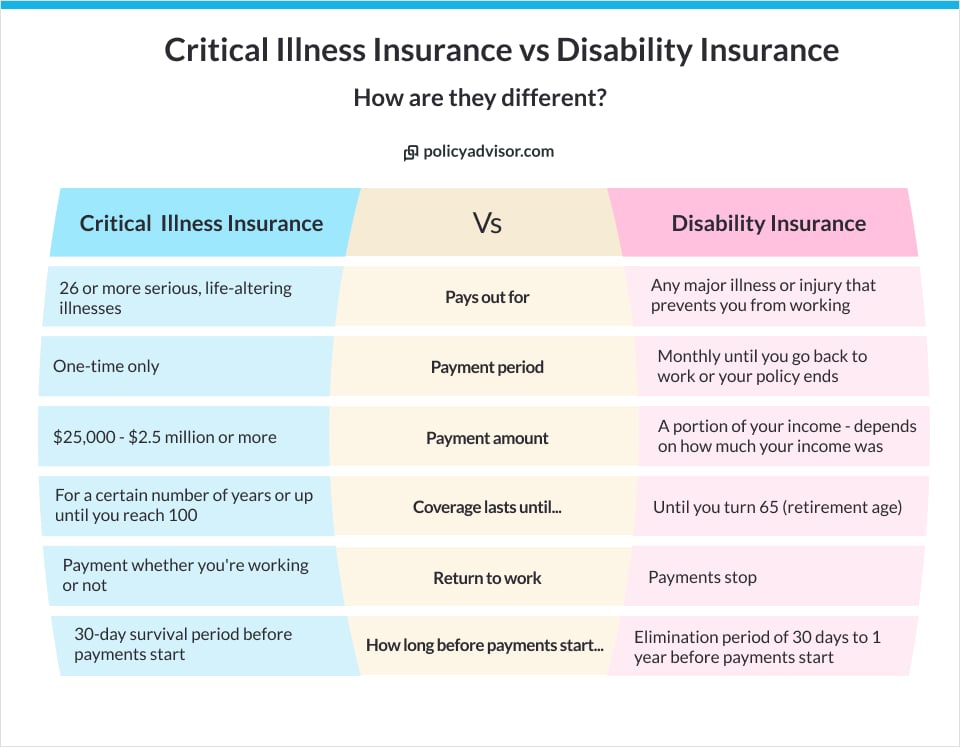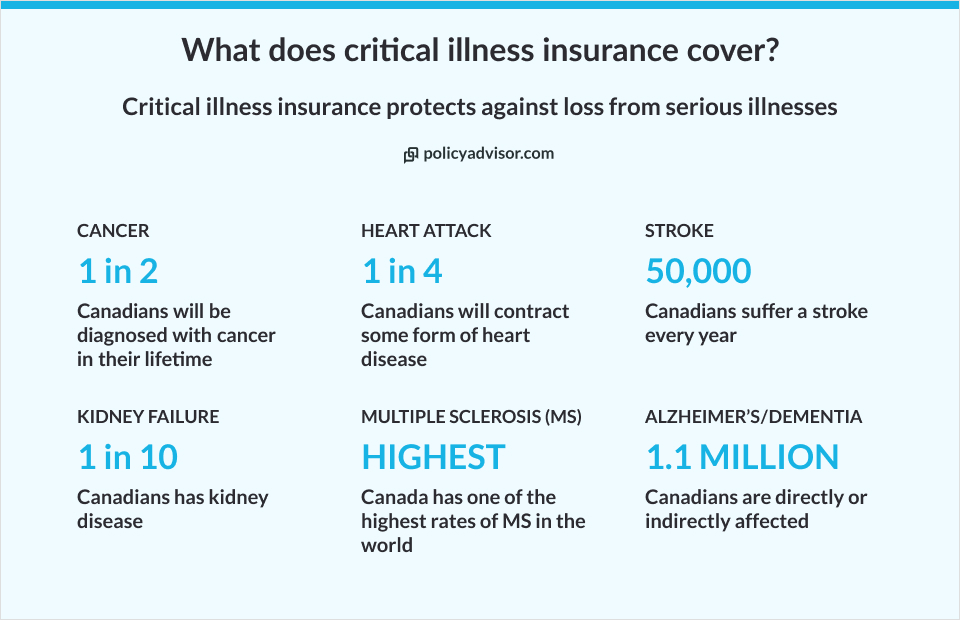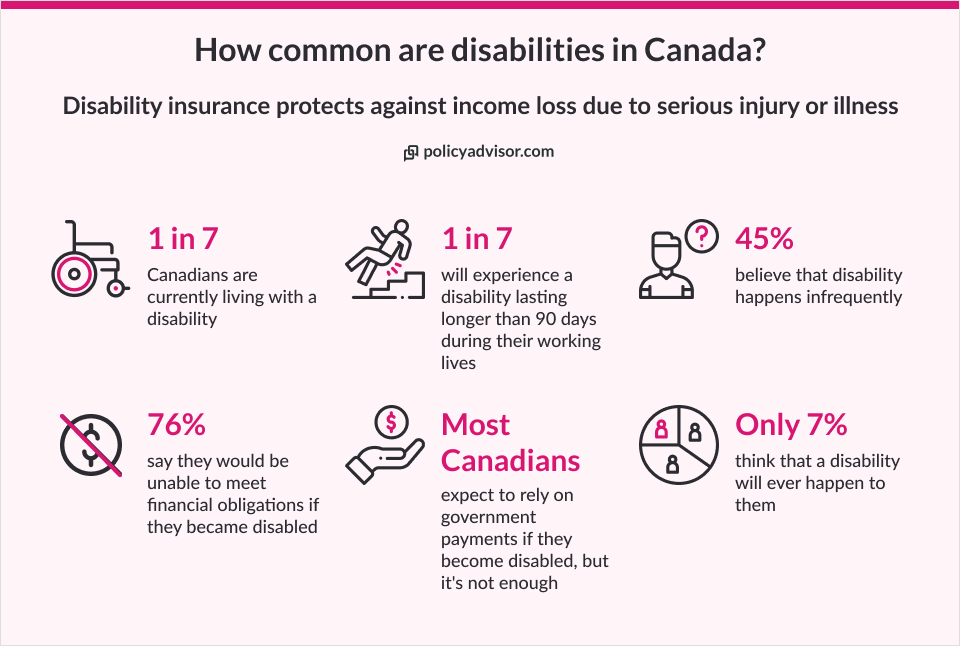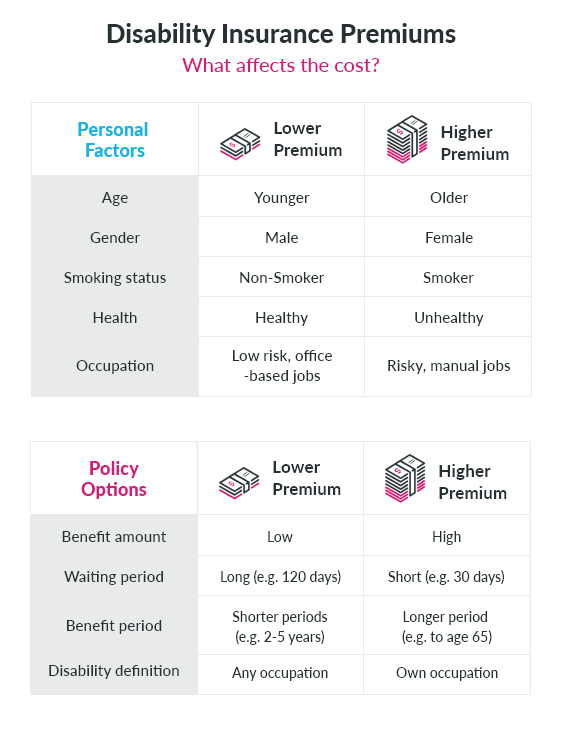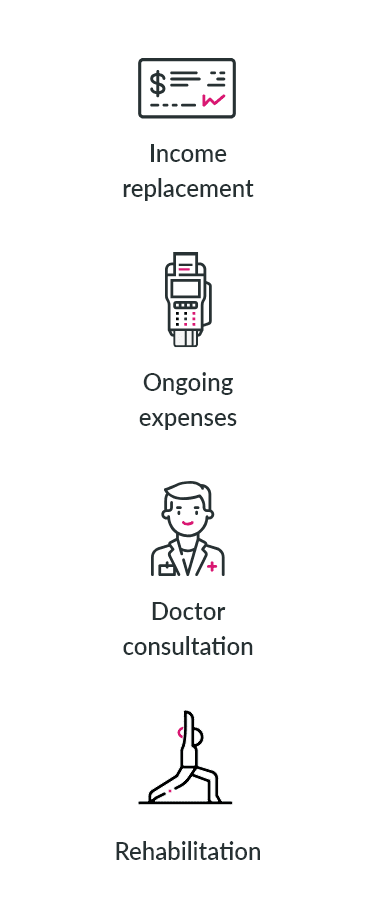Disability insurance is essential to protecting you and your family. It can replace a major loss of income if you are injured or ill and can’t work. However, as important as this protection is, nearly half of Canadians still don’t have any disability insurance.
Some employers provide short- and long-term disability insurance as a workplace benefit. However, the number of Canadians with disability coverage from their workplace declined from 57% in 2015 to 48% in 2018, as employers tighten their belts (source: RBC study). Without this employer coverage, Canadians can be left struggling to pay their bills and survive off savings — but this is where private disability insurance comes in.
If employers do offer coverage, they likely offer short-term coverage, so most already know the basics of this short-term disability. This article discusses long-term disability insurance in-depth—a coverage that most often benefits from buying independently owned policies. Read on to learn about what long-term disability is, how it works, the difference between employer individual plans, and what disabilities commonly qualify for coverage.
What is long-term disability insurance?
Long-term disability insurance provides income protection if you become unable to work due to a serious illness or injury. It typically replaces 50% to 70% of your income and kicks in after short-term disability benefits end.
Coverage can last two to five years, or even until age 65, depending on the policy. Common conditions that qualify for benefits include cancer, mental health disorders, and musculoskeletal injuries, helping individuals manage financial needs while recovering.
While employer-provided disability plans and government programs like EI, CPP, and WSIB offer some coverage, they often have limitations. Private long-term disability insurance allows you to customize coverage, choosing benefit amounts, coverage length, and waiting periods.
However, benefits cannot be stacked—you can only coordinate employer and private plans to ensure continued support. Many opt for individual policies to fill gaps in existing coverage and provide greater financial security in case of long-term disability.
What are the various types of long-term disability insurance?
There are two main types of long-term disability insurance: individual disability insurance and employer-sponsored disability insurance
- Employer-sponsored disability insurance – Offered through your workplace, this plan provides coverage for a portion of your salary if you become disabled. However, coverage may be limited, and benefits could be taxable
- Individual or personal disability insurance – Purchased privately, this plan allows you to choose how much coverage you need, the waiting period, and how long benefits last. It stays with you even if you change jobs
How does long-term disability insurance work?
You get long-term income coverage in exchange for the premiums you paid while you could work. This usually costs between one to three percent of your annual income. You are no longer required to make premium payments once your benefit period starts.
It’s important to note that long-term disability policies have a waiting period, also known as an elimination period. This is the time between the start of your disability and the beginning of your payment period. Waiting periods can be 4, 8, 12, 16, 20, or 52 weeks — the longer the waiting period, the lower your premiums. This is because your disability might recover before the end of the waiting period. If so, you can return to work, and there’s no longer a need for long-term disability payouts.
During the waiting period before your long-term coverage begins, you may have short-term disability benefits kick in. The significant distinction between short- and long-term disability insurance is that short-term disability insurance considers a benefit payout period in weeks. In contrast, long-term disability insurance considers the benefit period in years.
It’s important to remember that, due to the customizability of long-term disability policies, each plan differs in scope. For example, some policies may not cover mental health problems, despite it being a common long-term disability. Every policy will include its defined category of what a “disability” is.
Any occupation vs regular/own occupation plans
Long-term disability insurance is categorized into “any occupation” and “regular or own occupation” plans. Any occupation plans only allow you to receive disability benefits if you’re entirely unable to work — i.e., your illness or injury means you can’t perform the duties of any job you’re reasonably suited for.
For example, suppose you work as a cashier at a grocery store. You suddenly can’t perform cashier tasks, which require long periods of standing, due to an injury. In this case, you might still qualify to work as a store greeter, which can be done sitting down. You then wouldn’t be eligible for your policy’s disability benefits because you’re able to work another reasonably suited job despite your injury.
A regular or own occupation plan means that an inability to perform the primary duties of your role qualifies you for disability benefits. So even if you could still work another job, you would receive benefits if you’re unable to perform the role you had before the injury or illness.
Some insurers will end or reduce benefits, however, if they discover you begin working another role. We recommend own occupation plans for individuals with specialized professions that would require a significant pay cut if they chose to work in another field.
How long can you get long-term disability benefits from work?
Long-term disability insurance administered through your employer functions similarly to individual long-term disability insurance. A plan might provide two to five years of payouts or provide the benefit until your retirement age.
However, you might not have the option to choose the benefit period for an employer-sponsored plan. An employer is typically selecting the benefit period instead. If the selected period doesn’t work for your circumstance, it might be beneficial to look into private insurance.
Employers may also give employees the option to upgrade their work policy. But doing so can come at an additional cost. For example, suppose your employer-sponsored long-term disability plan pays 50% of your income for five years after a 120-day waiting period. The plan might have an upgrade option, where, in exchange for a $50 bi-weekly paycheque deduction, your employer’s long-term disability insurance now offers a benefit of 65% of your income until you’re 65 after a 120-day waiting period.
Again, each long-term disability insurance plan is unique. It’s critical to comb through the terms of your workplace insurance policy to understand how long benefits would remain if you could no longer work. You should also consider whether the benefit is enough to pay your usual expenses. At PolicyAdvisor, we’re happy to look at your existing policy to ensure you’re adequately covered.
If you need additional coverage, we can help you look into an individual long-term disability policy. Having an individual plan lets you go outside of your workplace plan’s limitations. You can choose your own waiting period, coverage period, and benefit amount with an individual plan.
Differences between group and individual long-term disability plans
| Group Plan | Individual Plan |
|---|---|
| Generally easy to sign up, and there’s usually no individual underwriting or medical examinations | You may have to go through an underwriting process, answer health-related questionnaires, and undergo a medical check |
| Your employer may pay for all or most of the premiums | You purchase the plan with your own after-tax income |
| If your employer pays the premiums, the benefits are taxable | Benefits are tax-free |
| Less expensive than individual plans due to reduced risk from pooling | More expensive than group plans |
| Limitations to what benefits you can receive | Customizable and robust — it’s bespoke to your needs |
| Dependent on continued employment with your employer | Carries over when you change jobs |
It’s critical to highlight that the application process for the two plans can be substantially different. The application process for individual plans is similar to life insurance. There’s an underwriting process where the insurer evaluates your risks depending on medical history, questionnaires, and medical examinations. They also need to verify your income level and work credentials since your benefit amount is based on these factors.
In contrast, group plans have a more accessible enrollment. Group plans might forego the whole underwriting process. However, insurers providing group plans are beginning to add employee health questionnaires to exclude risky individuals. Group plan insurers may also include exclusions for pre-existing conditions.
This emphasizes the importance of understanding what’s included in your workplace insurance policy. You may discover your employer-sponsored long-term disability insurance is inadequate and buy an individual plan to supplement it.
Is life insurance the same as long-term disability insurance?
Long-term disability insurance and life insurance are quite different. Life insurance is a legal agreement with your life insurance company to pay a designated beneficiary a tax-free lump sum amount upon your death.
Thus, the two main differences are:
- Life insurance is paid in a lump sum to your designated beneficiary, while long-term disability insurance is a periodic benefit payment to you.
- Life insurance payouts trigger on your death, while long-term disability payouts trigger after the waiting period after you face a disability.
Overall, disability insurance aims to cover your daily expenses when you can no longer earn an income. In contrast, life insurance provides your beneficiary, often your spouse or children, with a lump sum payment to cover funeral costs, debts, and other expenses after your death.
However, some life insurance policies offer a disability rider. This is essentially an add-on to life insurance coverage to accommodate the possibility of a disability. There are two key types of disability riders:
- Disability Waiver Rider: Eliminates life insurance premium payment requirements if you acquire a permanent disability
- Extreme Disability Rider: Pays out a portion of your life insurance benefit if you face a permanent disability
Although life insurance can accommodate disabilities through riders, it doesn’t replace a long-term disability policy. Riders don’t provide the flexibility and customizability that an individual long-term disability policy has. Riders also offer less protection, as it only pays out a portion of your life insurance benefits and doesn’t provide any ongoing income replacements.
How long do most long-term disability benefits last?
The duration of long-term disability benefits can vary based on the kind of disability that you have or the specific plan that you have purchased. Some companies offer disability benefits for a specific period such as 5 or 10 years, whereas other companies can extend their disability benefits until an individual reaches 65 years of age.
Many individuals choose coverage that lasts until they reach retirement age or can access other financial support, ensuring long-term financial security in case they are unable to return to work.
What illnesses qualify for long-term disability?
A long-term disability is a condition that prevents you from working for an extended period, typically several months to years. It can be caused by illness, injury, or chronic conditions and must meet the definition of disability in your insurance policy. Some of the most common long-term disabilities include:
- Serious illnesses (e.g., cancer, heart disease)
- Mental health disorders (e.g., severe depression, anxiety)
- Chronic conditions (e.g., multiple sclerosis, arthritis)
- Injuries (e.g., spinal cord damage, paralysis)
To qualify for benefits, your condition must significantly impact your ability to work and may require medical proof.
What are the examples of long-term disabilities that qualify for coverage?
Suppose you’re at a dinner party. Your hand feels a sudden paralysis, and you accidentally drop a wine glass. You continue to feel muscular weakness and pains and finally visit the doctor. After numerous tests, you discover you have Multiple Sclerosis (MS). MS eventually leads to an inability to walk and adequately use your legs.
After the diagnosis, you may begin to use sick days from your job at a furniture warehouse where you constantly move heavy items. After a week, you run out of sick days and move to short-term disability benefits. You might also receive EI and CPP disability benefits at this point. After 16 weeks, you transition from short-term disability and EI benefits to long-term disability benefits, which replace most of your prior income. The benefits continue until you reach 65.
Another example could involve mental health issues. If you suffer from severe depression and cannot work, you may go through similar motions as the previous example. However, suppose in this scenario, you recover and better manage your depression after three years. In this case, your long-term disability benefits would stop once you’re well enough to return to work.
Other common illnesses and injuries include:
- cardiovascular disease
- stroke
- cancer
- major car accidents
- arthritis
- mood disorders, including bipolar, anxiety, or depression
- PTSD
- mental health problems
- back injuries
- fractures
- head or brain injuries (concussions)
- brain injuries
- arthritis, rheumatoid arthritis
- diabetes
- nervous system disorders and seizures
- multiple sclerosis
- lupus
- fibromyalgias and chronic fatigue syndrome
- infection
- gastrointestinal illness (Crohn’s, colitis, irritable bowel syndrome, diverticulitis)
Does anxiety or mental health issues qualify for long-term disability?
Anxiety and mental health issues are some of the top reasons that people claim their long-term disability policies. However, each insurer and their plans are unique. Some cover mental health illnesses while others don’t.
As medical experts diagnose and recognize mental health issues on the same level as physical illnesses and injuries, more insurers are including conditions like anxiety in their disability coverage. There’s no guarantee that a policy covers mental health — some might require additional premiums to cover it or cite someone’s mental health history to exclude mental illnesses from the scope of the policy.
A policy’s scope can also account for the severity of the mental illness. Severe depression involving a medical diagnosis and drug treatments might justify a long-term disability payout. However, long-term leave from work due to stress may not necessarily trigger a policy’s coverage.
Should you get a long-term disability plan?
You need to think about your unique personal and family situation when deciding whether to buy long-term disability insurance. Consider the following:
- How much income will you need to replace if you can no longer earn a salary from your job?
- Could programs like EI or CPP or your workplace group disability insurance fully cover your expenses?
- Do you need to purchase additional coverage to make up the difference between what you currently earn and any income you’d receive if you faced an injury, accident, or disability?
These questions are challenging to answer. It might help to work with an insurance advisor to determine what type of long-term disability coverage you need. PolicyAdvisor’s expert advisors can suggest an individual long-term disability policy and match you to an insurer that fits your needs.
Schedule a call with one of our experts today. We can ensure you and your family are protected if you ever face an illness, accident, or injury that leaves you unable to work.
Where can I get the best disability insurance rates in Canada?
To get the best disability rates, you can start by comparing insurers and plans. You can use PolicyAdvisor’s disability insurance calculator to get a quick, no-obligation quote from Canada’s top insurers.
You can also reach out and speak to one of our licensed advisors who will help you with choosing the best plan and the application process. Plus, with PolicyAdvisor, you can connect back anytime and avail our lifetime after-sales support for all your future insurance queries.
Schedule a call with our experts today and protect yourself against life’s biggest challenges.
Frequently asked questions
Can I get long-term disability insurance if I’m self-employed?
Yes! Self-employed individuals can purchase individual long-term disability insurance to protect their income. Since they don’t have access to employer-provided benefits, this type of insurance ensures financial security if they become unable to work due to illness or injury.
Does long-term disability insurance cover mental health conditions?
Yes, some disability insurance policies do cover mental health-related disabilities, such as severe depression, anxiety disorders, or PTSD, but coverage varies by insurer. While some plans offer full benefits, others may have limitations or exclusions for mental health conditions. It’s important to carefully review the policy terms so that you do not find any surprises during times of need.
What happens to my long-term disability insurance if I recover and return to work?
If you recover before your benefit period ends, your disability payments will stop once you’re able to resume work. However, some policies include residual or partial disability benefits, which provide reduced payments if you can return to work part-time but not full-time. This can be helpful if your condition prevents you from working at your full capacity.
Do I have to pay taxes on long-term disability benefits?
Whether or not you pay taxes on long-term disability benefits depends on who pays the premiums. If your employer pays for the policy, any benefits you receive are generally taxable income. However, if you pay the premiums yourself using after-tax dollars, your benefits are tax-free.


 1-888-601-9980
1-888-601-9980